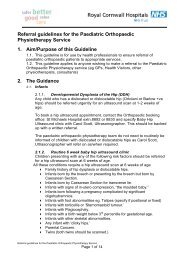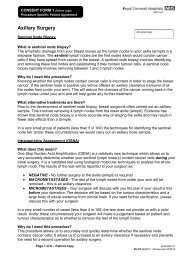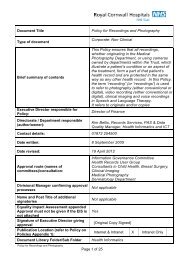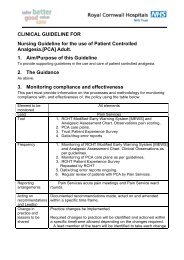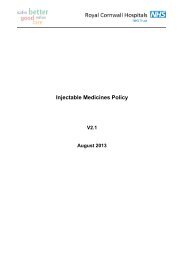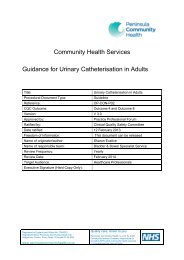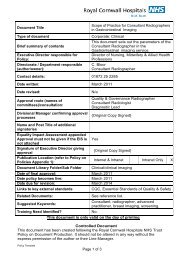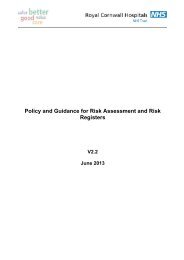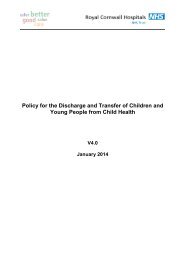clinical guideline for the prevention, diagnosis and treatment of early ...
clinical guideline for the prevention, diagnosis and treatment of early ...
clinical guideline for the prevention, diagnosis and treatment of early ...
Create successful ePaper yourself
Turn your PDF publications into a flip-book with our unique Google optimized e-Paper software.
CLINICAL GUIDELINE FOR THE PREVENTION, DIAGNOSIS<br />
AND TREATMENT OF EARLY-ONSET NEONATAL BACTERIAL<br />
INFECTION<br />
1. Aim/Purpose <strong>of</strong> this Guideline ...................................................................................... 2<br />
2. Scope <strong>of</strong> <strong>guideline</strong> ........................................................................................................ 2<br />
3. Background .................................................................................................................. 2<br />
4. Patient-centred care ..................................................................................................... 3<br />
5. Strategies during pregnancy to prevent neonatal EOI .................................................. 4<br />
5.1. Samples <strong>for</strong> bacterial culture during pregnancy ................................................. 4<br />
5.2. Antenatal antibiotic <strong>the</strong>rapy (be<strong>for</strong>e onset <strong>of</strong> labour) .......................................... 4<br />
5.3. Antenatal “flagging” <strong>of</strong> women who should be <strong>of</strong>fered IAP ................................ 4<br />
5.4. Avoidance <strong>of</strong> Listeria monocytogenes infection in pregnancy ............................ 5<br />
6. Intrapartum care to prevent neonatal EOI ..................................................................... 5<br />
6.1. Pre-labour rupture <strong>of</strong> membranes at term .......................................................... 5<br />
6.2. Suspected chorioamnionitis ............................................................................... 5<br />
6.3. Intra-partum antibiotic prophylaxis against <strong>early</strong>-onset GBS infection ............... 5<br />
7. Management <strong>of</strong> <strong>the</strong> Neonate ........................................................................................ 6<br />
7.1. Identifying infants with possible EOI .................................................................. 6<br />
7.2. Neonatal care-pathways based on risk factors <strong>and</strong> <strong>clinical</strong> indicators ............... 6<br />
7.3. Observation <strong>and</strong> Monitoring ............................................................................... 7<br />
7.4. Neonatal investigations <strong>for</strong> suspected EOI ........................................................ 7<br />
7.5. Empirical antibiotic <strong>the</strong>rapy <strong>for</strong> suspected EOI................................................... 8<br />
7.6. Gentamicin prescribing <strong>and</strong> monitoring .............................................................. 8<br />
7.7. Care <strong>of</strong> babies receiving antibiotics <strong>for</strong> suspected EOI. ..................................... 8<br />
7.8. Decisions 36 hours after starting <strong>treatment</strong> in babies with negative cultures ... 10<br />
7.9. Targeted antibiotic <strong>the</strong>rapy <strong>for</strong> culture-positive EOI ......................................... 10<br />
7.10. Localised infections <strong>of</strong> <strong>the</strong> eye ..................................................................... 11<br />
7.11. Localised infections <strong>of</strong> <strong>the</strong> umbilical cord ..................................................... 12<br />
7.12. Discharge after stopping antibiotic <strong>the</strong>rapy................................................... 12<br />
7.13. Footnote – IAP in preterm labour ................................................................. 12<br />
8. Monitoring compliance <strong>and</strong> effectiveness ................................................................... 12<br />
9. Equality <strong>and</strong> Diversity ................................................................................................. 12<br />
9.2. Equality Impact Assessment................................................................................ 13<br />
Appendix 1. Table 1 Risk factors <strong>for</strong> <strong>early</strong>-onset neonatal infection, including 'red flags' .. 14<br />
Appendix 2. Table 2 Clinical indicators <strong>of</strong> possible <strong>early</strong>-onset neonatal infection<br />
(observations <strong>and</strong> events in <strong>the</strong> baby), including 'red flags' ............................................... 15<br />
Appendix 3: Neonate Assessment Algorithm – determining <strong>the</strong> need <strong>for</strong> antibiotic <strong>the</strong>rapy<br />
........................................................................................................................................... 16<br />
Appendix 4. Governance In<strong>for</strong>mation ................................................................................ 17<br />
Appendix 5.Initial Equality Impact Assessment Screening Form ....................................... 19<br />
Clinical Guideline <strong>for</strong> <strong>the</strong> Prevention, Diagnosis <strong>and</strong> Treatment <strong>of</strong> Early-Onset Neonatal Bacterial Infection<br />
Page 1 <strong>of</strong> 20
1. Aim/Purpose <strong>of</strong> this Guideline<br />
• To provide guidance on antenatal <strong>and</strong> intrapartum <strong>clinical</strong> management to<br />
reduce risk <strong>of</strong> neonatal <strong>early</strong>-onset infection (EOI).<br />
• To provide guidance on <strong>the</strong> assessment <strong>and</strong> management <strong>of</strong> newborns at<br />
increased risk <strong>of</strong> EOI, <strong>and</strong> infants with suspected or proven EOI.<br />
2. Scope <strong>of</strong> <strong>guideline</strong><br />
• Pregnant women <strong>and</strong> newborn infants.<br />
• Prevention, <strong>diagnosis</strong> <strong>and</strong> <strong>treatment</strong> <strong>of</strong> neonatal infection with onset in <strong>the</strong> first<br />
72 hours <strong>of</strong> life.<br />
3. Background<br />
3.1. Early-onset bacterial infection is a significant cause <strong>of</strong> mortality <strong>and</strong> morbidity in<br />
newborn babies. The great majority <strong>of</strong> babies do not experience EOI but critical<br />
illness can develop quickly in affected babies. Pr<strong>of</strong>essional <strong>and</strong> public concern about<br />
<strong>the</strong> possibility <strong>of</strong> infection is common, but <strong>the</strong>re has been wide variation in how <strong>the</strong><br />
risk <strong>of</strong> <strong>early</strong>-onset neonatal infection is managed in mo<strong>the</strong>rs <strong>and</strong> healthy babies.<br />
3.2. Organisms responsible <strong>for</strong> neonatal EOI come from <strong>the</strong> maternal genital tract.<br />
The predominant pathogens causing EOI in <strong>the</strong> UK are GBS, non-pyogenic<br />
Streptococci, <strong>and</strong> E coli, though <strong>the</strong> list includes a range <strong>of</strong> o<strong>the</strong>r Gram positive <strong>and</strong><br />
Gram negative organisms. Listeria monocytogenes currently accounts <strong>for</strong> only 1% <strong>of</strong><br />
UK culture isolates in <strong>early</strong> onset sepsis.<br />
3.3. Group B Streptococcus (GBS, Streptococcus agalactiae) is <strong>the</strong> most frequent<br />
cause <strong>of</strong> severe neonatal EOI in <strong>the</strong> UK, accounting <strong>for</strong> 40% <strong>of</strong> all isolates in culturepositive<br />
cases. GBS is carried by approximately 25% <strong>of</strong> UK women <strong>of</strong> reproductive<br />
age, though EOI due to GBS affects less than 0.5% <strong>of</strong> babies born to GBS carriers.<br />
The estimated UK incidence <strong>of</strong> <strong>early</strong>-onset GBS (EOGBS) is 0.5 per 1000 births,<br />
though this incidence is may be an underestimate as it represents culture proven<br />
infection.<br />
3.4. This local <strong>guideline</strong> follows <strong>the</strong> NICE Clinical Guideline 149, “Antibiotics <strong>for</strong><br />
<strong>early</strong>-onset neonatal infection”, which toge<strong>the</strong>r with relevant guidance from <strong>the</strong> RCOG<br />
Green Top Guideline 36 “The Prevention <strong>of</strong> Early-onset Group B Streptococcal<br />
Disease” (2nd edition, 2012), <strong>and</strong> related NICE Clinical Guidelines (see reference list)<br />
is designed to ensure that:<br />
• Implementation <strong>of</strong> consistent preventive antenatal <strong>and</strong> intrapartum strategies;<br />
• rapid <strong>treatment</strong> <strong>of</strong> babies with suspected EOI;<br />
• limitation <strong>of</strong> antibiotic exposure in babies who do not have an EOI.<br />
3.5. Abbreviations<br />
IAP<br />
Intra-partum antibiotic prophylaxis<br />
EOI Early-onset bacterial infection<br />
GBS Group-B Streptococcus<br />
EOGBS Early-onset Group-B Streptococcus infection<br />
Clinical Guideline <strong>for</strong> <strong>the</strong> Prevention, Diagnosis <strong>and</strong> Treatment <strong>of</strong> Early-Onset Neonatal Bacterial Infection<br />
Page 2 <strong>of</strong> 20
PROM<br />
Pre-labour rupture <strong>of</strong> membranes<br />
4. Patient-centred care<br />
4.1. Except where it would be dangerous to do so, families should be <strong>of</strong>fered choice.<br />
Families should be supported to make choices through provision <strong>of</strong> in<strong>for</strong>mation <strong>and</strong>,<br />
where appropriate, reassurance.<br />
4.2. Healthcare pr<strong>of</strong>essionals should involve <strong>the</strong> mo<strong>the</strong>r in any h<strong>and</strong>over <strong>of</strong> care,<br />
ei<strong>the</strong>r when additional expertise is brought in because <strong>of</strong> <strong>the</strong> risk <strong>of</strong> infection or during<br />
planned changes in staff. The h<strong>and</strong>over should include an update about <strong>the</strong> presence<br />
<strong>of</strong> any infection.<br />
4.3. Parents should be reassured that babies at increased risk <strong>of</strong>, or with, EOI can<br />
usually continue to breastfeed, <strong>and</strong> that every ef<strong>for</strong>t will be made to facilitate this. If a<br />
baby is temporarily unable to breastfeed, <strong>the</strong> mo<strong>the</strong>r should be supported to express<br />
breast milk if she wishes to do so.<br />
4.4. If <strong>the</strong> mo<strong>the</strong>r had GBS colonisation in a previous pregnancy but without infection<br />
in <strong>the</strong> baby, she should be reassured that she does not require IAP in this pregnancy<br />
or any special precautions <strong>for</strong> her baby.<br />
4.5. If <strong>the</strong>re have been any concerns about <strong>early</strong>-onset neonatal infection be<strong>for</strong>e a<br />
baby is discharged, <strong>the</strong> parents should be advised that <strong>the</strong>y should seek medical<br />
advice if <strong>the</strong>y are concerned that <strong>the</strong> baby:<br />
• is showing abnormal behaviour (<strong>for</strong> example, inconsolable crying or<br />
listlessness), or<br />
• is unusually floppy, or<br />
• has developed difficulties with feeding or with tolerating feeds, or<br />
• has an abnormal temperature unexplained by environmental factors (lower than<br />
36°C or higher than 38°C), or<br />
• has rapid breathing, or<br />
• has a change in skin colour.<br />
4.6. When a baby who has had a GBS infection is discharged from hospital, <strong>the</strong><br />
mo<strong>the</strong>r should be advised that if she becomes pregnant again:<br />
• <strong>the</strong>re will be an increased risk <strong>of</strong> <strong>early</strong>-onset neonatal infection;<br />
• she should in<strong>for</strong>m her maternity care team that a previous baby has had a<br />
group B streptococcal infection;<br />
• IAP will be recommended.<br />
4.7. When a baby who has had a GBS infection is discharged from hospital, <strong>the</strong><br />
mo<strong>the</strong>r‟s GP should be advised that <strong>the</strong>re is a risk <strong>of</strong>:<br />
• recurrence <strong>of</strong> group B streptococcal infection in <strong>the</strong> baby, <strong>and</strong><br />
• Group B streptococcal infection in babies in future pregnancies.<br />
4.8. If <strong>the</strong> mo<strong>the</strong>r has had GBS colonisation in <strong>the</strong> pregnancy but without infection in<br />
<strong>the</strong> baby, she should be in<strong>for</strong>med that if she becomes pregnant again, this will not<br />
affect <strong>the</strong> management <strong>of</strong> <strong>the</strong> birth in <strong>the</strong> next pregnancy.<br />
Clinical Guideline <strong>for</strong> <strong>the</strong> Prevention, Diagnosis <strong>and</strong> Treatment <strong>of</strong> Early-Onset Neonatal Bacterial Infection<br />
Page 3 <strong>of</strong> 20
5. Strategies during pregnancy to prevent neonatal EOI<br />
5.1. Samples <strong>for</strong> bacterial culture during pregnancy<br />
5.1.1. Women should be <strong>of</strong>fered routine screening <strong>for</strong> asymptomatic<br />
bacteriuria (bacterial colonisation <strong>of</strong> <strong>the</strong> urinary tract without urinary tract<br />
symptoms) by midstream urine culture <strong>early</strong> in pregnancy.<br />
5.1.2. Routine antenatal screening <strong>for</strong> asymptomatic bacterial vaginosis is<br />
not recommended.<br />
5.1.3. Routine antenatal screening <strong>of</strong> pregnant women <strong>for</strong> GBS carriage is<br />
not recommended.<br />
5.2. Antenatal antibiotic <strong>the</strong>rapy (be<strong>for</strong>e onset <strong>of</strong> labour)<br />
5.2.1. Vaginal GBS colonisation:<br />
Benzylpenicillin prophylaxis during pregnancy (be<strong>for</strong>e onset <strong>of</strong> labour) does not<br />
reduce <strong>the</strong> likelihood <strong>of</strong> GBS colonisation at delivery <strong>and</strong> is not an effective<br />
preventive strategy. Women found to have vaginal or rectal colonisation with<br />
GBS during pregnancy should be <strong>of</strong>fered IAP from <strong>the</strong> start <strong>of</strong> labour.<br />
5.2.2. Bacteriuria:<br />
Treatment <strong>of</strong> asymptomatic bacteriuria in pregnancy reduces <strong>the</strong> risk <strong>of</strong> maternal<br />
pyelonephritis. There<strong>for</strong>e women with significant bacteriuria should receive<br />
antibiotic <strong>treatment</strong> appropriate to <strong>the</strong> organism identified. Women treated in<br />
pregnancy <strong>for</strong> GBS bacteriuria should also be <strong>of</strong>fered IAP.<br />
5.2.3. Preterm pre-labour rupture <strong>of</strong> membranes:<br />
Oral erythromycin should be <strong>of</strong>fered <strong>for</strong> 10 days following a <strong>diagnosis</strong> <strong>of</strong> preterm<br />
pre-labour rupture <strong>of</strong> membranes.<br />
5.3. Antenatal “flagging” <strong>of</strong> women who should be <strong>of</strong>fered IAP<br />
5.3.1. The following women should be cl<strong>early</strong> identified as eligible <strong>for</strong> intrapartum<br />
antibiotic <strong>the</strong>rapy:<br />
• Women with previous baby affected by neonatal GBS disease;<br />
• Women with GBS on rectal or high vaginal swab in current pregnancy;<br />
• Women with GBS bacteriuria in current pregnancy.<br />
5.3.2. All women identified antenatally with any <strong>of</strong> <strong>the</strong>se indications <strong>for</strong> IAP<br />
should have a yellow GBS sticker placed on <strong>the</strong> „maternity management plan<br />
page‟ <strong>and</strong> a letter sent to <strong>the</strong> delivery suite „risk‟ folder.<br />
5.3.3. When antibiotics are administered during labour this should be signed<br />
<strong>for</strong> on <strong>the</strong> prescription chart <strong>and</strong> documented in <strong>the</strong> woman‟s intrapartum<br />
records.<br />
Clinical Guideline <strong>for</strong> <strong>the</strong> Prevention, Diagnosis <strong>and</strong> Treatment <strong>of</strong> Early-Onset Neonatal Bacterial Infection<br />
Page 4 <strong>of</strong> 20
5.4. Avoidance <strong>of</strong> Listeria monocytogenes infection in pregnancy<br />
5.4.1. In<strong>for</strong>mation <strong>of</strong>fered to pregnant women should include how to reduce<br />
<strong>the</strong> risk <strong>of</strong> listeriosis by:<br />
• drinking only pasteurised or ultra-heat treated (UHT) milk<br />
• avoiding ripened s<strong>of</strong>t cheeses, <strong>for</strong> example camembert, brie <strong>and</strong> blueveined<br />
cheese<br />
• (<strong>the</strong>re is no risk with hard cheeses, such as cheddar, or cottage cheese or<br />
processed cheese)<br />
• not eating pâté <strong>of</strong> any kind (including vegetable pâté)<br />
• not eating uncooked or undercooked ready-prepared meals.<br />
6. Intrapartum care to prevent neonatal EOI<br />
6.1. Pre-labour rupture <strong>of</strong> membranes at term<br />
Women who present with PROM but have not had GBS detected in <strong>the</strong>ir urine or on<br />
swab in <strong>the</strong> current pregnancy or have not had a previously infected baby, <strong>the</strong>n<br />
induction <strong>of</strong> labour should be advised 24 hours after rupture <strong>of</strong> membranes, unless<br />
<strong>the</strong>re is a <strong>clinical</strong> indication to induce earlier. See „Clinical Guideline <strong>for</strong> <strong>the</strong><br />
Management <strong>of</strong> Prelabour Rupture <strong>of</strong> Membrane at Term (Term PROM) 2012‟.<br />
Routine IAP is not advocated. Mo<strong>the</strong>rs <strong>of</strong> babies born following PROM should be<br />
asked to in<strong>for</strong>m <strong>the</strong>ir healthcare pr<strong>of</strong>essionals immediately <strong>of</strong> any concerns <strong>the</strong>y have<br />
about <strong>the</strong>ir baby‟s wellbeing in <strong>the</strong> first 5 days following birth, particularly in <strong>the</strong> first 12<br />
hours when <strong>the</strong> risk <strong>of</strong> infection is greatest.<br />
6.2. Suspected chorioamnionitis<br />
Women with a fever > 38°C in labour or with <strong>clinical</strong>ly suspected chorioamnionitis<br />
should:<br />
• have a blood sample sent <strong>for</strong> blood culture.<br />
• commence broad spectrum IV antibiotic <strong>the</strong>rapy, including an antibiotic active<br />
against GBS.<br />
• have placenta sent <strong>for</strong> culture <strong>and</strong> histology following delivery.<br />
6.3. Intra-partum antibiotic prophylaxis against <strong>early</strong>-onset GBS infection<br />
IAP reduces <strong>the</strong> risk <strong>of</strong> neonatal EOI in babies born to women colonized or infected<br />
with GBS. The recommendations on use <strong>of</strong> IAP against GBS seek to balance <strong>the</strong><br />
reduction in risk <strong>of</strong> neonatal infection with <strong>the</strong> increased medicalisation <strong>of</strong> childbirth,<br />
risk <strong>of</strong> adverse antibiotic reaction, <strong>and</strong> <strong>the</strong> potential promotion <strong>of</strong> resistant organisms.<br />
6.3.1. Recommended regime <strong>for</strong> IAP against GBS:<br />
• Benzyl penicillin 3g IV <strong>the</strong>n 1.5g at 4 hourly intervals until delivery<br />
• If <strong>the</strong> woman is allergic to penicillin Clindamycin 900mg IV every 8 hours<br />
until delivery<br />
6.3.2. Definition <strong>of</strong> “adequate” IAP against GBS:<br />
Clinical Guideline <strong>for</strong> <strong>the</strong> Prevention, Diagnosis <strong>and</strong> Treatment <strong>of</strong> Early-Onset Neonatal Bacterial Infection<br />
Page 5 <strong>of</strong> 20
• Adequate IAP is defined as at least one dose <strong>of</strong> one <strong>the</strong> above antibiotic<br />
regimes, given at least 2 hours be<strong>for</strong>e delivery.<br />
6.3.3. Indications <strong>for</strong> IAP to prevent neonatal <strong>early</strong>-onset GBS infection:<br />
IAP against GBS should be <strong>of</strong>fered to:<br />
• Women who have had a previous baby with invasive GBS infection<br />
• Women who have been found to have GBS colonisation, bacteriuria or<br />
infection in <strong>the</strong> current pregnancy<br />
NB - Erythromycin does not provide effective prophylaxis against <strong>early</strong>onset<br />
GBS).<br />
6.3.4. Women who are not recommended to receive IAP:<br />
• Women with GBS colonisation, bacteriuria or infection in previous<br />
pregnancies or at any o<strong>the</strong>r time be<strong>for</strong>e <strong>the</strong> current pregnancy, unless<br />
<strong>the</strong>re is a history <strong>of</strong> neonatal GBS disease.<br />
• Women delivering by elective caesarean section in <strong>the</strong> absence <strong>of</strong> labour,<br />
regardless <strong>of</strong> GBS colonisation status in <strong>the</strong> current pregnancy.<br />
• Women in preterm labour with intact membranes who are not known to<br />
have been colonised with GBS in <strong>the</strong> current pregnancy.<br />
• Women in preterm labour following prelabour ROM, unless <strong>the</strong>re is<br />
evidence <strong>of</strong> overt infection (in which case commence broad spectrum IV<br />
antibiotic <strong>the</strong>rapy including an agent active against GBS, as per 6.3).<br />
7. Management <strong>of</strong> <strong>the</strong> Neonate<br />
7.1. Identifying infants with possible EOI<br />
• Management <strong>of</strong> <strong>the</strong> newborn infant within <strong>the</strong> first 72 hours <strong>of</strong> life should be<br />
based on an assessment <strong>of</strong> risk factors <strong>and</strong> <strong>clinical</strong> indicators (see Tables,<br />
Appendix 1 <strong>and</strong> 2). Certain risk factors <strong>and</strong> <strong>clinical</strong> indicators in Tables 1 <strong>and</strong> 2<br />
are “red flags” which signify a high likelihood <strong>of</strong> <strong>early</strong>-onset neonatal infection.<br />
• Any risk factor or <strong>clinical</strong> indicator identified by maternity staff be<strong>for</strong>e or<br />
following delivery should prompt a careful <strong>clinical</strong> assessment <strong>of</strong> <strong>the</strong> baby<br />
without delay. This should include a review <strong>of</strong> <strong>the</strong> maternal <strong>and</strong> neonatal<br />
history <strong>and</strong> a physical examination <strong>of</strong> <strong>the</strong> baby including an assessment <strong>of</strong> vital<br />
signs.<br />
7.2. Neonatal care-pathways based on risk factors <strong>and</strong> <strong>clinical</strong> indicators<br />
(See summary algorithm Appendix 3)<br />
7.2.1. Infant with any red flag:<br />
• Investigate (Section 7.4) <strong>and</strong> Treat (Section 7.5)<br />
7.2.2. No red flags, but two or more non-red flag risk factors or <strong>clinical</strong><br />
indicators:<br />
Clinical Guideline <strong>for</strong> <strong>the</strong> Prevention, Diagnosis <strong>and</strong> Treatment <strong>of</strong> Early-Onset Neonatal Bacterial Infection<br />
Page 6 <strong>of</strong> 20
• Investigate (Section 7.4) <strong>and</strong> Treat (Section 7.5)<br />
7.2.3. No red flags, <strong>and</strong> only one non-red flag risk factor or <strong>clinical</strong> indicator:<br />
• Consider withholding antibiotics<br />
• Observe <strong>and</strong> Monitor (section 7.3)<br />
• If one or more fur<strong>the</strong>r <strong>clinical</strong> indicator develops: Investigate (Section 7.4)<br />
<strong>and</strong> Treat (Section 7.5)<br />
• If no fur<strong>the</strong>r concerns arise during observation <strong>and</strong> monitoring period,<br />
reassure parents <strong>and</strong> give advice to parents <strong>and</strong> carers.<br />
7.2.4. No risk factors or <strong>clinical</strong> indicators:<br />
• Continue routine postnatal care.<br />
NB:<br />
• Maternal GBS colonisation, bacteriuria or infection in <strong>the</strong> current<br />
pregnancy constitutes a risk factor after delivery <strong>of</strong> <strong>the</strong> baby if <strong>the</strong> mo<strong>the</strong>r<br />
has not received adequate IAP (see definition <strong>of</strong> adequate IAP, Section<br />
2.37).<br />
• If maternal GBS colonisation is first identified after birth but within <strong>the</strong> first<br />
72 hours <strong>of</strong> life, <strong>the</strong> baby should be assessed <strong>for</strong> any o<strong>the</strong>r risk factors <strong>and</strong><br />
any <strong>clinical</strong> indicators <strong>of</strong> infection. Then follow <strong>the</strong> algorithm in this section<br />
above.<br />
7.3. Observation <strong>and</strong> Monitoring<br />
• Monitoring is appropriate <strong>for</strong> babies with only one non-red flag risk factor or<br />
<strong>clinical</strong> indicator. Monitoring should include documentation <strong>of</strong> <strong>clinical</strong> condition<br />
<strong>and</strong> vital signs (temperature, pulse <strong>and</strong> respiratory rate) at 0, 1, <strong>and</strong> 2 hours,<br />
<strong>and</strong> <strong>the</strong>n 2-hourly <strong>for</strong> at least a fur<strong>the</strong>r 10 hours.<br />
7.4. Neonatal investigations <strong>for</strong> suspected EOI<br />
7.4.1. A Blood Culture <strong>and</strong> sample <strong>for</strong> CRP should always be taken be<strong>for</strong>e<br />
administering <strong>the</strong> first dose <strong>of</strong> antibiotic. Routine urine flow cytometry/ culture is<br />
not recommended.<br />
7.4.2. A second CRP should be measured 18-24 hours after presentation.<br />
7.4.3. Surface skin swabs <strong>for</strong> culture are not recommended in ei<strong>the</strong>r well or<br />
unwell babies, in <strong>the</strong> absence <strong>of</strong> <strong>clinical</strong> signs <strong>of</strong> a localised infection.<br />
7.4.4. A lumbar puncture should be per<strong>for</strong>med be<strong>for</strong>e starting antibiotics if it<br />
is safe to do so <strong>and</strong> <strong>the</strong>re is a strong <strong>clinical</strong> suspicion <strong>of</strong> infection. If per<strong>for</strong>ming<br />
lumbar puncture would delay starting antibiotics beyond a safe duration<br />
(maximum 1 hour), per<strong>for</strong>m <strong>the</strong> LP as soon as possible after starting antibiotics.<br />
7.4.5. If an LP was not done at presentation, an LP should be considered if:<br />
Clinical Guideline <strong>for</strong> <strong>the</strong> Prevention, Diagnosis <strong>and</strong> Treatment <strong>of</strong> Early-Onset Neonatal Bacterial Infection<br />
Page 7 <strong>of</strong> 20
• <strong>the</strong> baby has a CRP greater than 10 mg/l, or<br />
• blood culture is positive, or<br />
• <strong>the</strong>re is an unsatisfactory response to antibiotic <strong>treatment</strong><br />
7.4.6. A chest X-Ray should be per<strong>for</strong>med if <strong>the</strong>re are <strong>clinical</strong> signs <strong>of</strong><br />
respiratory disease (NB: no recommendation in NICE <strong>guideline</strong>).<br />
7.5. Empirical antibiotic <strong>the</strong>rapy <strong>for</strong> suspected EOI<br />
7.5.1. Babies commenced on antibiotic <strong>treatment</strong> should receive <strong>the</strong> first<br />
dose as soon as possible <strong>and</strong> always within 1 hour <strong>of</strong> <strong>the</strong> decision to treat.<br />
7.5.2. Babies commenced on antibiotics <strong>for</strong> suspected <strong>early</strong>-onset neonatal<br />
infection should receive:<br />
• IV Benzlpenicillin 25 mg/kg every 12 hours (8-hourly if very ill), <strong>and</strong><br />
• IV Gentamicin, starting dose 5 mg/kg.<br />
7.5.3. If a second Gentamicin dose is needed it should be given 36 hours<br />
after <strong>the</strong> first dose, or after 24 hours if <strong>the</strong> baby is very ill or <strong>the</strong> blood culture<br />
shows a Gram-negative organism.<br />
7.5.4. Babies commenced on antibiotics should be assessed regularly <strong>and</strong><br />
<strong>the</strong> antibiotic regimen reviewed on <strong>the</strong> basis <strong>of</strong> <strong>the</strong> baby‟s <strong>clinical</strong> condition <strong>and</strong><br />
culture results.<br />
7.6. Gentamicin prescribing <strong>and</strong> monitoring<br />
7.6.1. RCHT policy on safe prescribing <strong>and</strong> administration <strong>of</strong> gentamicin must<br />
be followed.<br />
7.6.2. If a second dose <strong>of</strong> gentamicin is given, measure <strong>the</strong> trough<br />
gentamicin level immediately be<strong>for</strong>e <strong>the</strong> second dose. Check <strong>the</strong> result <strong>of</strong> <strong>the</strong><br />
pre-second dose gentamicin level be<strong>for</strong>e giving a third dose.<br />
7.6.3. If <strong>the</strong> baby is continued on gentamicin, re-check <strong>the</strong> trough level be<strong>for</strong>e<br />
every 3rd dose, or more frequently if necessary. Aim to achieve trough<br />
concentrations below 2 mg/l, or below 1 mg/l <strong>for</strong> course lengths exceeding three<br />
doses.<br />
7.6.4. Consider measuring peak blood gentamicin levels 1 hour after<br />
gentamicin dose in babies with:<br />
• Oedema<br />
• Macrosomia<br />
• Unsatisfactory response to antibiotic <strong>the</strong>rapy<br />
• Proven Gram-negative infection<br />
If measured, consider increasing <strong>the</strong> gentamicin dose if peak level is less than 8<br />
mg/l.<br />
7.7. Care <strong>of</strong> babies receiving antibiotics <strong>for</strong> suspected EOI.<br />
Clinical Guideline <strong>for</strong> <strong>the</strong> Prevention, Diagnosis <strong>and</strong> Treatment <strong>of</strong> Early-Onset Neonatal Bacterial Infection<br />
Page 8 <strong>of</strong> 20
7.7.1. All babies started on antibiotics in <strong>the</strong> first 72 hours <strong>of</strong> life should<br />
receive <strong>the</strong> first dose on NNU with a set <strong>of</strong> observations recorded at <strong>the</strong> time.<br />
Care <strong>of</strong> <strong>the</strong> baby should <strong>the</strong>n be guided by <strong>clinical</strong> presentation as follows:<br />
7.7.2. Antibiotics started <strong>for</strong> risk factors with no <strong>clinical</strong> indicators:<br />
Babies started on antibiotics when <strong>the</strong>re are no <strong>clinical</strong> indicators <strong>of</strong> infection (i.e.<br />
treated on basis <strong>of</strong> risk factors only), <strong>and</strong> no red flag risk factors, can be nursed<br />
with <strong>the</strong>ir mo<strong>the</strong>rs on <strong>the</strong> Postnatal Ward. They should have initial observations<br />
at 1, 2, 4, 8, <strong>and</strong> 12 hours, <strong>and</strong> subsequently at least 6 times in each 24 hours<br />
until <strong>the</strong> cannula has been removed following completion <strong>of</strong> antibiotic <strong>the</strong>rapy<br />
(where appropriate, timed to coincide with feeds or o<strong>the</strong>r cares). All<br />
observations should be documented on <strong>the</strong> Neonatal Early Warning Score<br />
(Neonatal NEWS) chart.<br />
7.7.3. Antibiotics started in presence <strong>of</strong> one <strong>clinical</strong> indicator:<br />
Babies started on antibiotics when <strong>the</strong>re are one or more risk factors but only<br />
one <strong>clinical</strong> indicator <strong>of</strong> infection should be assessed by a paediatric Consultant,<br />
Middle Grade Doctor or ANNP to decide whe<strong>the</strong>r continuing care should be on<br />
NNU, transitional care or postnatal ward. Assessment should take into account<br />
<strong>the</strong> nature <strong>and</strong> severity <strong>of</strong> symptoms, <strong>the</strong> potential <strong>for</strong> babies with symptoms <strong>of</strong><br />
sepsis to deteriorate, as well as <strong>the</strong> disadvantages <strong>of</strong> separating mo<strong>the</strong>r <strong>and</strong><br />
baby.<br />
They should have initial observations at 1, 2, 4, 8, <strong>and</strong> 12 hours, <strong>and</strong><br />
subsequently at least 6 times in each 24 hours until <strong>the</strong> cannula has been<br />
removed following completion <strong>of</strong> antibiotic <strong>the</strong>rapy (where appropriate, timed to<br />
coincide with feeds or o<strong>the</strong>r cares). All observations should be documented on<br />
<strong>the</strong> Neonatal Early Warning Score (Neonatal NEWS) chart.<br />
7.7.4. Antibiotics started in presence <strong>of</strong> more than one <strong>clinical</strong> indicator:<br />
Babies with more than one <strong>clinical</strong> indicator should be nursed on NNU <strong>for</strong> at<br />
least 12 hours after <strong>the</strong> first antibiotic dose, <strong>and</strong> should remain on NNU until<br />
considered fit to be nursed with mo<strong>the</strong>r on postnatal ward. They should <strong>the</strong>n<br />
have observations documented at least 6 times in each 24 hours until <strong>the</strong><br />
cannula has been removed following completion <strong>of</strong> antibiotic <strong>the</strong>rapy (where<br />
appropriate, timed to coincide with feeds or o<strong>the</strong>r cares). All observations<br />
should be documented on <strong>the</strong> Neonatal Early Warning Score (Neonatal NEWS)<br />
chart.<br />
7.7.5. Senior oversight <strong>of</strong> babies with EOI<br />
The Neonatal Service consultant (or on-call consultant on weekends) should be<br />
in<strong>for</strong>med <strong>of</strong> all infants considered to have EOI (defined as infant with positive<br />
culture from blood, or CSF, or considered to require antibiotics <strong>for</strong> more than 36<br />
hours on <strong>clinical</strong> grounds). The consultant has responsibility to ensure that <strong>the</strong><br />
<strong>diagnosis</strong> <strong>and</strong> <strong>treatment</strong> plan are appropriate <strong>and</strong> that parents are adequately<br />
in<strong>for</strong>med.<br />
Clinical Guideline <strong>for</strong> <strong>the</strong> Prevention, Diagnosis <strong>and</strong> Treatment <strong>of</strong> Early-Onset Neonatal Bacterial Infection<br />
Page 9 <strong>of</strong> 20
7.8. Decisions 36 hours after starting <strong>treatment</strong> in babies with negative<br />
cultures<br />
7.8.1. The usual duration <strong>of</strong> antibiotic <strong>treatment</strong> <strong>for</strong> babies with a negative<br />
blood culture but in whom <strong>the</strong>re has been strong suspicion <strong>of</strong> sepsis should be 7<br />
days.<br />
7.8.2. Consider stopping antibiotics 36 hours after starting antibiotics if:<br />
• The blood culture is negative, <strong>and</strong><br />
• The initial suspicion <strong>of</strong> infection was not strong, <strong>and</strong><br />
• The baby‟s <strong>clinical</strong> condition is reassuring with no <strong>clinical</strong> indicators <strong>of</strong><br />
possible infection, <strong>and</strong><br />
• The levels <strong>and</strong> trend <strong>of</strong> CRP are reassuring<br />
7.8.3. If blood culture is negative but it is decided to continue beyond 36<br />
hours, <strong>the</strong> baby should have a <strong>clinical</strong> review at least once every 24 hours. At<br />
each review, consider whe<strong>the</strong>r to stop or continue antibiotic <strong>treatment</strong>, taking<br />
account <strong>of</strong>:<br />
• <strong>the</strong> level <strong>of</strong> initial <strong>clinical</strong> suspicion <strong>of</strong> infection<br />
• <strong>the</strong> baby's <strong>clinical</strong> progress <strong>and</strong> current condition, <strong>and</strong><br />
• <strong>the</strong> levels <strong>and</strong> trends <strong>of</strong> C-reactive protein concentration.<br />
7.9. Targeted antibiotic <strong>the</strong>rapy <strong>for</strong> culture-positive EOI<br />
7.9.1. Neonatal <strong>early</strong>-onset bacteraemia:<br />
• Gram-negative organism grown on blood culture:<br />
o<br />
o<br />
Add ano<strong>the</strong>r antibiotic active against Gram-negatives (eg<br />
Cefotaxime).<br />
If gram-negative infection is confirmed, stop <strong>the</strong> Benzylpenicillin.<br />
• GBS or Listeria grown on blood culture:<br />
o<br />
Continue Benzylpenicillin <strong>and</strong> Gentamicin.<br />
• Gram-positive species o<strong>the</strong>r than GBS or Listeria grown on blood culture<br />
o<br />
Seek expert Clinical Microbiological advice.<br />
7.9.1.1. Duration <strong>of</strong> <strong>the</strong>rapy:<br />
The st<strong>and</strong>ard antibiotic <strong>treatment</strong> length <strong>for</strong> blood culture-positive EOI is 7<br />
days. Consider a longer duration if <strong>the</strong> baby has not fully recovered or if<br />
advisable based on <strong>the</strong> isolated pathogen (seek Clinical Microbiology<br />
advice).<br />
7.9.2. Neonatal <strong>early</strong>-onset meningitis:<br />
• Empirical <strong>treatment</strong> pending CSF culture:<br />
Clinical Guideline <strong>for</strong> <strong>the</strong> Prevention, Diagnosis <strong>and</strong> Treatment <strong>of</strong> Early-Onset Neonatal Bacterial Infection<br />
Page 10 <strong>of</strong> 20
• I V Amoxicillin <strong>and</strong> Cefotaxime<br />
• Gram-negative species identified on CSF Gram-stain or culture:<br />
o<br />
o<br />
o<br />
Stop <strong>the</strong> Amoxicillin <strong>and</strong> treat with Cefotaxime alone.<br />
Continue <strong>treatment</strong> <strong>for</strong> at least 21 days unless directed o<strong>the</strong>rwise by<br />
<strong>the</strong> results <strong>of</strong> antibiotic susceptibilities.<br />
If <strong>the</strong> <strong>clinical</strong> course is complicated consider extending <strong>the</strong> duration<br />
<strong>of</strong> <strong>treatment</strong> <strong>and</strong> obtain expert advice.<br />
• Gram-positive species identified on CSF Gram-stain:<br />
o<br />
o<br />
Continue Amoxicillin <strong>and</strong> Cefotaxime pending CSF culture result<br />
Seek Clinical Microbiological advice.<br />
• GBS isolated from CSF culture:<br />
o<br />
Consider changing antibiotic combination to:<br />
Benzylpenicillin 50 mg/kg every 12 hours <strong>for</strong> at least 14 days,<br />
<strong>and</strong><br />
Gentamicin, starting dose 5 mg/kg every 36 hours* <strong>for</strong> 5 days.<br />
*or every 24 hours if <strong>the</strong> baby is very ill or a Gram-negative organism is cultured.<br />
• Listeria isolated from CSF (or from blood culture in neonate with<br />
meningitis):<br />
o<br />
o<br />
o<br />
Stop Cefotaxime <strong>and</strong> treat with Amoxicillin <strong>and</strong> Gentamicin.<br />
Continue IV Amoxicillin <strong>for</strong> at least 21 days<br />
Treat with Gentamicin <strong>for</strong> at least <strong>the</strong> first 7 days.<br />
• Gram-positive species o<strong>the</strong>r than GBS or Listeria isolated from CSF<br />
culture:<br />
o<br />
Seek senior Clinical Microbiological advice.<br />
• Gram-stain <strong>and</strong> culture negative meningitis:<br />
o<br />
o<br />
Treat with Cefotaxime <strong>and</strong> Amoxicillin <strong>for</strong> at least 14 days.<br />
If <strong>the</strong> <strong>clinical</strong> course is complicated, consider extending <strong>the</strong> duration<br />
<strong>of</strong> <strong>treatment</strong> <strong>and</strong> seek advice.<br />
7.10. Localised infections <strong>of</strong> <strong>the</strong> eye<br />
7.10.1. Babies with a significant purulent eye discharge within first 72 hours<br />
should have st<strong>and</strong>ard eye swabs sent urgently <strong>for</strong> gram stain <strong>and</strong> culture, <strong>and</strong><br />
Chlamydia eye swab <strong>for</strong> PCR. Start topical <strong>and</strong> systemic antibiotic <strong>the</strong>rapy <strong>for</strong><br />
possible gonococcal infection whilst awaiting swab results (topical Neomycin<br />
plus single dose IV Ceftriaxone if infant not jaundiced; if jaundiced, start IV<br />
Cefotaxime <strong>and</strong> seek Clinical Microbiology advice). Specific <strong>the</strong>rapy should be<br />
guided by microbiology results.<br />
Clinical Guideline <strong>for</strong> <strong>the</strong> Prevention, Diagnosis <strong>and</strong> Treatment <strong>of</strong> Early-Onset Neonatal Bacterial Infection<br />
Page 11 <strong>of</strong> 20
7.11. Localised infections <strong>of</strong> <strong>the</strong> umbilical cord<br />
7.11.1. Babies with purulent umbilical discharge or peri-umbilical cellulitis<br />
should have blood culture, CRP, <strong>and</strong> umbilical swab <strong>for</strong> Gram stain <strong>and</strong> culture.<br />
Start IV Flucloxacillin <strong>and</strong> Gentamicin, following <strong>the</strong> gentamicin regime <strong>and</strong><br />
guidance in Section 2.47. If culture shows a Gram-positive organism, <strong>the</strong><br />
gentamicin should be stopped.<br />
7.12. Discharge after stopping antibiotic <strong>the</strong>rapy<br />
It is not necessary to keep a well baby in hospital <strong>for</strong> observation after stopping<br />
antibiotics. Consider prompt discharge but parents/ carers should be given support<br />
<strong>and</strong> in<strong>for</strong>mation as per Section 2.2 <strong>and</strong> a point <strong>of</strong> contact <strong>for</strong> advice.<br />
7.13. Footnote – IAP in preterm labour<br />
Multiple poor-quality <strong>clinical</strong> trials have toge<strong>the</strong>r failed to yield sufficient evidence to<br />
determine whe<strong>the</strong>r IAP against GBS should be <strong>of</strong>fered to women presenting with<br />
preterm labour, in <strong>the</strong> absence <strong>of</strong> <strong>clinical</strong> chorioamnionitis or known GBS colonisation/<br />
bacteriuria in <strong>the</strong> current pregnancy. For women with preterm prelabour ROM, NICE<br />
Guideline 149 says “consider” IAP, whilst <strong>the</strong> 2nd ed RCOG Green Top Guideline<br />
no.36 says IAP should not be <strong>of</strong>fered to this group.<br />
Nei<strong>the</strong>r <strong>guideline</strong> recommends IAP against GBS in preterm labour with intact<br />
membranes.<br />
8. Monitoring compliance <strong>and</strong> effectiveness<br />
Element to be<br />
monitored<br />
Lead<br />
Key changes in practice recommended by guidance.<br />
Dr Andrew Collinson, Operational Lead <strong>for</strong> Neonatology<br />
Tool<br />
Frequency<br />
Reporting<br />
arrangements<br />
Acting on<br />
recommendations<br />
<strong>and</strong> Lead(s)<br />
Change in<br />
practice <strong>and</strong><br />
lessons to be<br />
shared<br />
Audit pro<strong>for</strong>ma to be developed.<br />
First audit 6 months after introduction, <strong>the</strong>n as dictated by audit<br />
findings.<br />
Child Health Directorate Audit <strong>and</strong> Clinical Guidelines Meetings<br />
Andrew Collinson, Consultant Paediatrician<br />
Karen Watkins, Consultant Obstetrician<br />
Required changes to practice will be identified <strong>and</strong> actioned within 3<br />
month <strong>of</strong> first audit. A lead member <strong>of</strong> <strong>the</strong> team will be identified to<br />
take each change <strong>for</strong>ward where appropriate. Lessons will be shared<br />
with all <strong>the</strong> relevant stakeholders.<br />
9. Equality <strong>and</strong> Diversity<br />
9.1. This document complies with <strong>the</strong> Royal Cornwall Hospitals NHS Trust service<br />
Equality <strong>and</strong> Diversity statement.<br />
Clinical Guideline <strong>for</strong> <strong>the</strong> Prevention, Diagnosis <strong>and</strong> Treatment <strong>of</strong> Early-Onset Neonatal Bacterial Infection<br />
Page 12 <strong>of</strong> 20
9.2. Equality Impact Assessment<br />
The Initial Equality Impact Assessment Screening Form is at Appendix 5.<br />
Clinical Guideline <strong>for</strong> <strong>the</strong> Prevention, Diagnosis <strong>and</strong> Treatment <strong>of</strong> Early-Onset Neonatal Bacterial Infection<br />
Page 13 <strong>of</strong> 20
Appendix 1. Table 1 Risk factors <strong>for</strong> <strong>early</strong>-onset neonatal<br />
infection, including 'red flags'<br />
Risk factor<br />
Parenteral antibiotic <strong>treatment</strong> given to <strong>the</strong> woman <strong>for</strong> confirmed or suspected<br />
invasive bacterial infection (such as septicaemia) at any time during labour, or in<br />
<strong>the</strong> 24-hour periods be<strong>for</strong>e <strong>and</strong> after <strong>the</strong> birth [This does not refer to intrapartum<br />
antibiotic prophylaxis]<br />
Suspected or confirmed infection in ano<strong>the</strong>r baby in <strong>the</strong> case <strong>of</strong> a multiple<br />
pregnancy<br />
Invasive group B streptococcal infection in a previous baby<br />
Maternal group B streptococcal colonisation, bacteriuria or infection in <strong>the</strong> current<br />
pregnancy<br />
Prelabour rupture <strong>of</strong> membranes<br />
Preterm birth following spontaneous labour (be<strong>for</strong>e 37 weeks' gestation)<br />
Suspected or confirmed rupture <strong>of</strong> membranes <strong>for</strong> more than 18 hours in a preterm<br />
birth<br />
Intrapartum fever higher than 38°C, or confirmed or suspected chorioamnionitis<br />
Red<br />
flag?<br />
Yes<br />
Yes<br />
Clinical Guideline <strong>for</strong> <strong>the</strong> Prevention, Diagnosis <strong>and</strong> Treatment <strong>of</strong> Early-Onset Neonatal Bacterial Infection<br />
Page 14 <strong>of</strong> 20
Appendix 2. Table 2 Clinical indicators <strong>of</strong> possible <strong>early</strong>-onset<br />
neonatal infection (observations <strong>and</strong> events in <strong>the</strong> baby),<br />
including 'red flags'<br />
Clinical indicator<br />
Respiratory distress starting more than 4 hours after birth<br />
Need <strong>for</strong> mechanical ventilation in a term baby<br />
Signs <strong>of</strong> shock<br />
Seizures<br />
Altered behaviour or responsiveness<br />
Altered muscle tone (<strong>for</strong> example, floppiness)<br />
Feeding difficulties (<strong>for</strong> example, feed refusal)<br />
Feed intolerance, including vomiting, excessive gastric aspirates <strong>and</strong> abdominal<br />
distension<br />
Abnormal heart rate (bradycardia or tachycardia)<br />
Signs <strong>of</strong> respiratory distress<br />
Hypoxia (<strong>for</strong> example, central cyanosis or reduced oxygen saturation level)<br />
Jaundice within 24 hours <strong>of</strong> birth<br />
Apnoea<br />
Signs <strong>of</strong> neonatal encephalopathy<br />
Need <strong>for</strong> cardio–pulmonary resuscitation<br />
Need <strong>for</strong> mechanical ventilation in a preterm baby<br />
Persistent fetal circulation (persistent pulmonary hypertension)<br />
Temperature abnormality (lower than 36°C or higher than 38°C) unexplained by<br />
environmental factors<br />
Unexplained excessive bleeding, thrombocytopenia, or abnormal coagulation<br />
(International Normalised Ratio greater than 2.0)<br />
Oliguria persisting beyond 24 hours after birth<br />
Altered glucose homeostasis (hypoglycaemia or hyperglycaemia)<br />
Metabolic acidosis (base deficit <strong>of</strong> 10 mmol/litre or greater)<br />
Local signs <strong>of</strong> infection (<strong>for</strong> example, affecting <strong>the</strong> skin or eye)<br />
Red<br />
flag?<br />
Yes<br />
Yes<br />
Yes<br />
Yes<br />
Clinical Guideline <strong>for</strong> <strong>the</strong> Prevention, Diagnosis <strong>and</strong> Treatment <strong>of</strong> Early-Onset Neonatal Bacterial Infection<br />
Page 15 <strong>of</strong> 20
Appendix 3: Neonate Assessment Algorithm – determining <strong>the</strong><br />
need <strong>for</strong> antibiotic <strong>the</strong>rapy<br />
“Reproduced from: NCC-WCH/NICE/RCOG/RCM Clinical Guideline. Antibiotics <strong>for</strong> <strong>early</strong>-onset neonatal infection:antibiotics <strong>for</strong> <strong>the</strong><br />
<strong>prevention</strong> <strong>and</strong> <strong>treatment</strong> <strong>of</strong> <strong>early</strong>-onset neonatal infection. London: RCOG; 2012, with <strong>the</strong> permission <strong>of</strong> <strong>the</strong> Royal College <strong>of</strong><br />
Obstetricians <strong>and</strong> Gynaecologists on behalf <strong>of</strong> <strong>the</strong> NCC-WCH.”<br />
Clinical Guideline <strong>for</strong> <strong>the</strong> Prevention, Diagnosis <strong>and</strong> Treatment <strong>of</strong> Early-Onset Neonatal Bacterial Infection<br />
Page 16 <strong>of</strong> 20
Appendix 4. Governance In<strong>for</strong>mation<br />
Document Title<br />
Date Issued/Approved: 21 Oct 13<br />
Date Valid From: 21 Oct 13<br />
Date Valid To: 21 Oct 16<br />
Directorate / Department responsible<br />
(author/owner):<br />
Contact details: 01872 255081<br />
Brief summary <strong>of</strong> contents<br />
Suggested Keywords:<br />
Target Audience<br />
Executive Director responsible <strong>for</strong><br />
Policy:<br />
Clinical Guideline <strong>for</strong> <strong>the</strong> Prevention,<br />
Diagnosis <strong>and</strong> Treatment <strong>of</strong> Early-Onset<br />
Neonatal Bacterial Infection<br />
Andrew Collinson, Consultant in Paediatrics<br />
<strong>and</strong> Neonatology<br />
This <strong>guideline</strong> is designed to ensure <strong>the</strong><br />
implementation <strong>of</strong> consistent preventive<br />
antenatal <strong>and</strong> intrapartum strategies; <strong>the</strong><br />
rapid <strong>treatment</strong> <strong>of</strong> babies with suspected<br />
EOI <strong>and</strong> <strong>the</strong> limitation <strong>of</strong> antibiotic exposure<br />
in babies who do not have an EOI.<br />
Neonatal, infection, antibiotics, bacterial<br />
infection<br />
RCHT PCT CFT<br />
<br />
Medical Director<br />
Date revised: 21 Oct 13<br />
This document replaces (exact title <strong>of</strong><br />
previous version):<br />
Approval route (names <strong>of</strong><br />
committees)/consultation:<br />
Clinical Guideline <strong>for</strong> <strong>the</strong> Prevention,<br />
Diagnosis <strong>and</strong> Treatment <strong>of</strong> Early-Onset<br />
Neonatal Bacterial Infection<br />
Not Required<br />
Divisional Manager confirming<br />
approval processes<br />
Name <strong>and</strong> Post Title <strong>of</strong> additional<br />
signatories<br />
Signature <strong>of</strong> Executive Director giving<br />
approval<br />
Publication Location (refer to Policy<br />
on Policies – Approvals <strong>and</strong><br />
Ratification):<br />
Document Library Folder/Sub Folder<br />
Links to key external st<strong>and</strong>ards<br />
Related Documents:<br />
Andrew Collinson, Consultant in Paediatrics<br />
<strong>and</strong> Neonatology<br />
Not Required<br />
{Original Copy Signed}<br />
Internet & Intranet<br />
Clinical / Neonatal<br />
None<br />
Intranet Only<br />
• NICE Clinical Guideline 149: Antibiotics <strong>for</strong><br />
<strong>early</strong>-onset neonatal infection.<br />
Clinical Guideline <strong>for</strong> <strong>the</strong> Prevention, Diagnosis <strong>and</strong> Treatment <strong>of</strong> Early-Onset Neonatal Bacterial Infection<br />
Page 17 <strong>of</strong> 20
• RCOG Green Top Guideline no.36: The<br />
<strong>prevention</strong> <strong>of</strong> <strong>early</strong>-onset neonatal Group B<br />
Streptococcal Disease.<br />
• RCOG Green Top Guideline no. 44:<br />
Preterm prelabour rupture <strong>of</strong> membranes.<br />
• NICE Clinical Guideline 62: Antenatal care:<br />
routine care <strong>for</strong> <strong>the</strong> healthy pregnant<br />
woman.<br />
• NICE Clinical Guideline 55: Intrapartum<br />
care: management <strong>and</strong> delivery <strong>of</strong> care to<br />
women in labour.<br />
• NICE Clinical Guideline 70: Induction <strong>of</strong><br />
labour<br />
Training Need Identified?<br />
• NICE Clinical Guideline 102: Bacterial<br />
meningitis <strong>and</strong> meningococcal septicaemia<br />
No<br />
Version Control Table<br />
Date<br />
Versio<br />
n No<br />
19 Mar 13 V1.0 Initial Issue<br />
21 Oct 13 V1.1<br />
Summary <strong>of</strong> Changes<br />
Para „7.7. Care <strong>of</strong> babies receiving<br />
antibiotics <strong>for</strong> suspected EOI‟ amended<br />
Changes Made by<br />
(Name <strong>and</strong> Job Title)<br />
Andrew Collinson,<br />
Consultant in<br />
Paediatrics <strong>and</strong><br />
Neonatology<br />
Andrew Collinson,<br />
Consultant in<br />
Paediatrics <strong>and</strong><br />
Neonatology<br />
All or part <strong>of</strong> this document can be released under <strong>the</strong> Freedom <strong>of</strong> In<strong>for</strong>mation<br />
Act 2000<br />
This document is to be retained <strong>for</strong> 10 years from <strong>the</strong> date <strong>of</strong> expiry.<br />
This document is only valid on <strong>the</strong> day <strong>of</strong> printing<br />
Controlled Document<br />
This document has been created following <strong>the</strong> Royal Cornwall Hospitals NHS Trust<br />
Policy on Document Production. It should not be altered in any way without <strong>the</strong><br />
express permission <strong>of</strong> <strong>the</strong> author or <strong>the</strong>ir Line Manager.<br />
Clinical Guideline <strong>for</strong> <strong>the</strong> Prevention, Diagnosis <strong>and</strong> Treatment <strong>of</strong> Early-Onset Neonatal Bacterial Infection<br />
Page 18 <strong>of</strong> 20
Appendix 5.Initial Equality Impact Assessment Screening Form<br />
Name <strong>of</strong> service, strategy, policy or project (hereafter referred to as policy) to be<br />
assessed: Clinical Guideline <strong>for</strong> <strong>the</strong> Prevention, Diagnosis <strong>and</strong> Treatment <strong>of</strong> Early-<br />
Onset Neonatal Bacterial Infection<br />
Directorate <strong>and</strong> service area: Neonatal Is this a new or existing Procedure? New<br />
Name <strong>of</strong> individual completing<br />
Telephone: 01872 255081<br />
assessment: Andrew Collinson <strong>and</strong><br />
Karen Watkins<br />
1. Policy Aim* • To provide guidance on antenatal <strong>and</strong> intrapartum<br />
<strong>clinical</strong> management to reduce risk <strong>of</strong> neonatal <strong>early</strong>-onset<br />
infection (EOI).<br />
• To provide guidance on <strong>the</strong> assessment <strong>and</strong><br />
management <strong>of</strong> newborns at increased risk <strong>of</strong> EOI, <strong>and</strong><br />
infants with suspected or proven EOI.<br />
2. Policy Objectives* As above.<br />
3. Policy – intended<br />
Outcomes*<br />
10. How will you<br />
measure <strong>the</strong> outcome?<br />
5. Who is intended to<br />
benefit from <strong>the</strong> Policy?<br />
This <strong>guideline</strong> is designed to ensure <strong>the</strong> implementation <strong>of</strong><br />
consistent preventive antenatal <strong>and</strong> intrapartum strategies;<br />
<strong>the</strong> rapid <strong>treatment</strong> <strong>of</strong> babies with suspected EOI <strong>and</strong> <strong>the</strong><br />
limitation <strong>of</strong> antibiotic exposure in babies who do not have<br />
an EOI.<br />
See section 3 <strong>of</strong> this <strong>guideline</strong>.<br />
Neonatal patients<br />
6a. Is consultation<br />
required with <strong>the</strong><br />
work<strong>for</strong>ce, equality<br />
groups, local interest<br />
groups etc. around this<br />
policy?<br />
No<br />
b. If yes, have <strong>the</strong>se<br />
groups been consulted?<br />
c. Please list any groups<br />
who have been consulted<br />
about this procedure.<br />
*Please see Glossary<br />
7. The Impact<br />
Please complete <strong>the</strong> following table using ticks. You should refer to <strong>the</strong> EA guidance notes<br />
<strong>for</strong> areas <strong>of</strong> possible impact <strong>and</strong> also <strong>the</strong> Glossary if needed.<br />
Clinical Guideline <strong>for</strong> <strong>the</strong> Prevention, Diagnosis <strong>and</strong> Treatment <strong>of</strong> Early-Onset Neonatal Bacterial Infection<br />
Page 19 <strong>of</strong> 20
Where you think that <strong>the</strong> policy could have a positive impact on any <strong>of</strong> <strong>the</strong> equality<br />
group(s) like promoting equality <strong>and</strong> equal opportunities or improving relations<br />
within equality groups, tick <strong>the</strong> „Positive impact‟ box.<br />
Where you think that <strong>the</strong> policy could have a negative impact on any <strong>of</strong> <strong>the</strong> equality<br />
group(s) i.e. it could disadvantage <strong>the</strong>m, tick <strong>the</strong> „Negative impact‟ box.<br />
Where you think that <strong>the</strong> policy has no impact on any <strong>of</strong> <strong>the</strong> equality group(s) listed<br />
below i.e. it has no effect currently on equality groups, tick <strong>the</strong> „No impact‟ box.<br />
Equality<br />
Group<br />
Age<br />
Positive<br />
Impact<br />
Negative<br />
Impact<br />
No<br />
Impact<br />
<br />
Reasons <strong>for</strong> decision<br />
Disability<br />
Religion or<br />
belief<br />
Gender<br />
Transgender<br />
Pregnancy/<br />
Maternity<br />
Race<br />
Sexual<br />
Orientation<br />
Marriage / Civil<br />
Partnership<br />
<br />
<br />
<br />
<br />
<br />
<br />
<br />
<br />
You will need to continue to a full Equality Impact Assessment if <strong>the</strong> following have<br />
been highlighted:<br />
A negative impact <strong>and</strong><br />
No consultation (this excludes any policies which have been identified as not<br />
requiring consultation).<br />
8. If <strong>the</strong>re is no evidence that <strong>the</strong> policy<br />
promotes equality, equal opportunities<br />
or improved relations - could it be<br />
adapted so that it does? How?<br />
Full statement <strong>of</strong> commitment to policy <strong>of</strong><br />
equal opportunities is included in <strong>the</strong> policy<br />
Please sign <strong>and</strong> date this <strong>for</strong>m.<br />
Keep one copy <strong>and</strong> send a copy to Matron, Equality, Diversity <strong>and</strong> Human Rights,<br />
c/o Royal Cornwall Hospitals NHS Trust, Human Resources Department, Chyvean<br />
House, Penventinnie Lane, Truro, Cornwall, TR1 3LJ<br />
A summary <strong>of</strong> <strong>the</strong> results will be published on <strong>the</strong> Trust‟s web site.<br />
Signed ________________________________________<br />
Date _________________________________________<br />
Clinical Guideline <strong>for</strong> <strong>the</strong> Prevention, Diagnosis <strong>and</strong> Treatment <strong>of</strong> Early-Onset Neonatal Bacterial Infection<br />
Page 20 <strong>of</strong> 20




